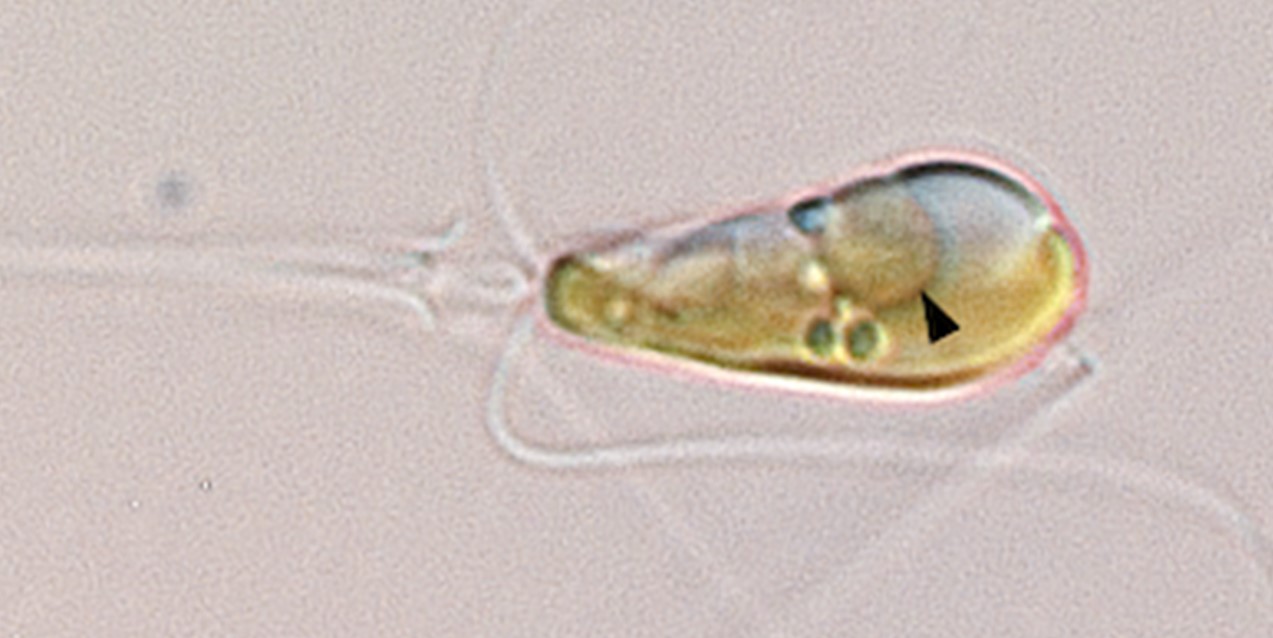
Credit: Tyler Coale via Astrobiology
Three times in Earth’s long history, a process called endosymbiosis has occurred. And it has totally changed life on Earth.
Two billion years ago, all life was single-celled organisms in an oxygen-free environment.
Some of these bacteria-like creatures engulfed others into their cell walls and began a symbiotic relationship called endosymbiosis.
The smaller organisms became organelles within the larger cell—most importantly, the mitochondria—providing energy to the cell in exchange for protection and nourishment.
As oxygen levels rose, these more sophisticated single-cell creatures thrived and would eventually develop into multicellular life-forms.
Six-hundred million years ago, another very important merging occurred.
This time, cells absorbed a bacterium that could perform photosynthesis. It became another organelle, the chloroplast, and with those, the larger organisms evolved into plants.
Today, scientists have discovered a third important endosymbiosis underway. Some algae have engulfed nitrogen-fixing bacteria, which have become a new kind of organelle—a nitroplast.
This allows the algae to secure their own nitrogen, vital for plant function, directly from air. And it could have huge potential in fertilizer research for human agriculture, too.
The mitochondria enabled multicellular life. The chloroplast gave rise to plants. What changes could the nitroplast bring?
Background
Synopsis: Twice in Earth’s history, microscopic mergers at the cellular level enabled huge evolutionary leaps. Around 2 billion years ago, a single-celled archaean engulfed a single-celled bacterium that became a mitochondrion, creating the powerhouse of multicellular life. Hundreds of millions of years later, one of these organisms consumed a photosynthetic cyanobacteria that turned into an organelle called a chloroplast, enabling photosynthesis in plants and algae. Now, scientists have identified a third organelle-forming event, in which a marine alga has been found in the act of incorporating a nitrogen-fixing bacterium within its cellular structure to create a nitroplast.
- For many millions of years, Earth’s earliest life-forms were simple, single-celled organisms like today’s archaea and bacteria.
- These organisms are called prokaryotes (“before kernel” in Greek) because they have no nucleus. Their single chromosome of circular DNA floats around the cell.
- They have flexible cell walls that enable them to completely engulf their prey.
- Prokaryotes are the ancestors of eukaryotes.
- Around 2.2 billion years ago, eukaryotes (“good kernel” in Greek) evolved by enclosing their genetic material within a membrane-bound nucleus.
- One of the most important distinctions among groups of organisms is the difference between prokaryotes and eukaryotes, the enclosed nucleus.
- The genetic material of eukaryotes contains multiple linear diploidal chromosomes.
- Eukaryotes may be single-celled or multicellular. Animals, plants, fungi and protists are all eukaryotes.
- They may have additional organelles within the cell that perform specific critical cell functions, like mitochondria, chloroplasts, Golgi apparatuses, endoplasmic reticula and lysosomes, each of which are protected by membranes.
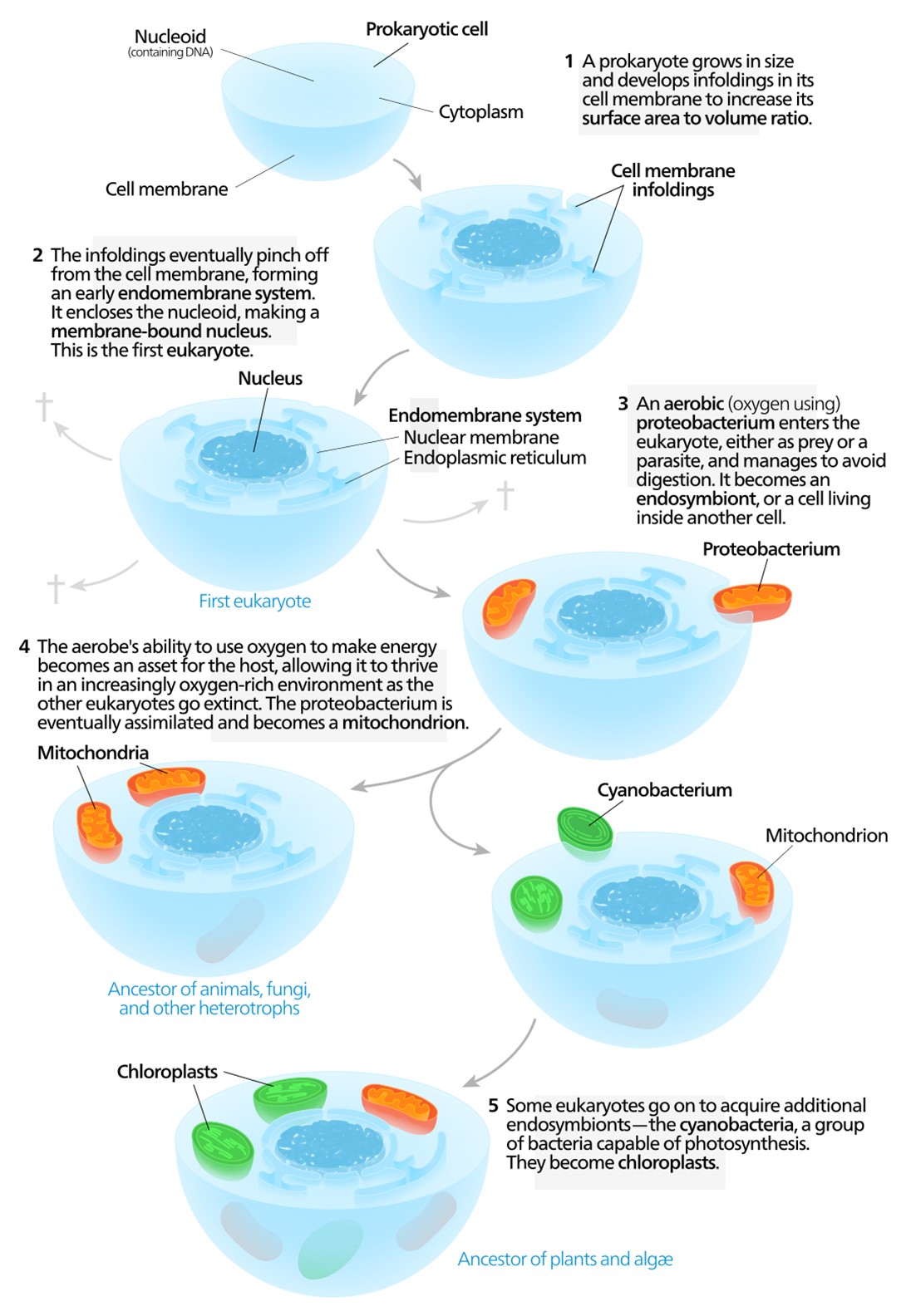
Mitochondria and chloroplasts likely evolved from engulfed prokaryotes that once lived as independent organisms. At some point, a eukaryotic cell engulfed an aerobic prokaryote that then formed an endosymbiotic relationship with the host eukaryote, gradually developing into a mitochondrion. Eukaryotic cells containing mitochondria then engulfed photosynthetic prokaryotes that evolved to become specialized chloroplast organelles in plants and algae.
Credit: Kelvinsong, CC BY-SA 3.0, via Wikimedia Commons
- Not long afterward, the next big leap in cellular evolution occurred by primary endosymbiosis, a situation that occurs when one previously independent cell lives inside another previously independent living cell with mutual benefit for both.
- With low oxygen levels, most life on Earth was anaerobic.
- At some point an anaerobic nucleated protist cell engulfed some aerobic protobacteria.
- These internal symbionts (endosymbionts) used atmospheric oxygen to produce energy for the host, helping it to survive increasing oxygen levels as other less fortunate eukaryotes perished.
- The host provided the endosymbiont with protection, nutrients and energy.
- Groups of similar host cells followed the same process.
- As they became more and more essential to survival, the host cells assimilated the symbionts, which became membrane-bound organelles called mitochondria.
- Mitochondria are known as the powerhouses of multicellular life because they use aerobic respiration of oxygen to produce adenosine triphosphate (ATP), molecules used by cells to store and transfer energy like tiny energy banks. They are essential for multicellular life.
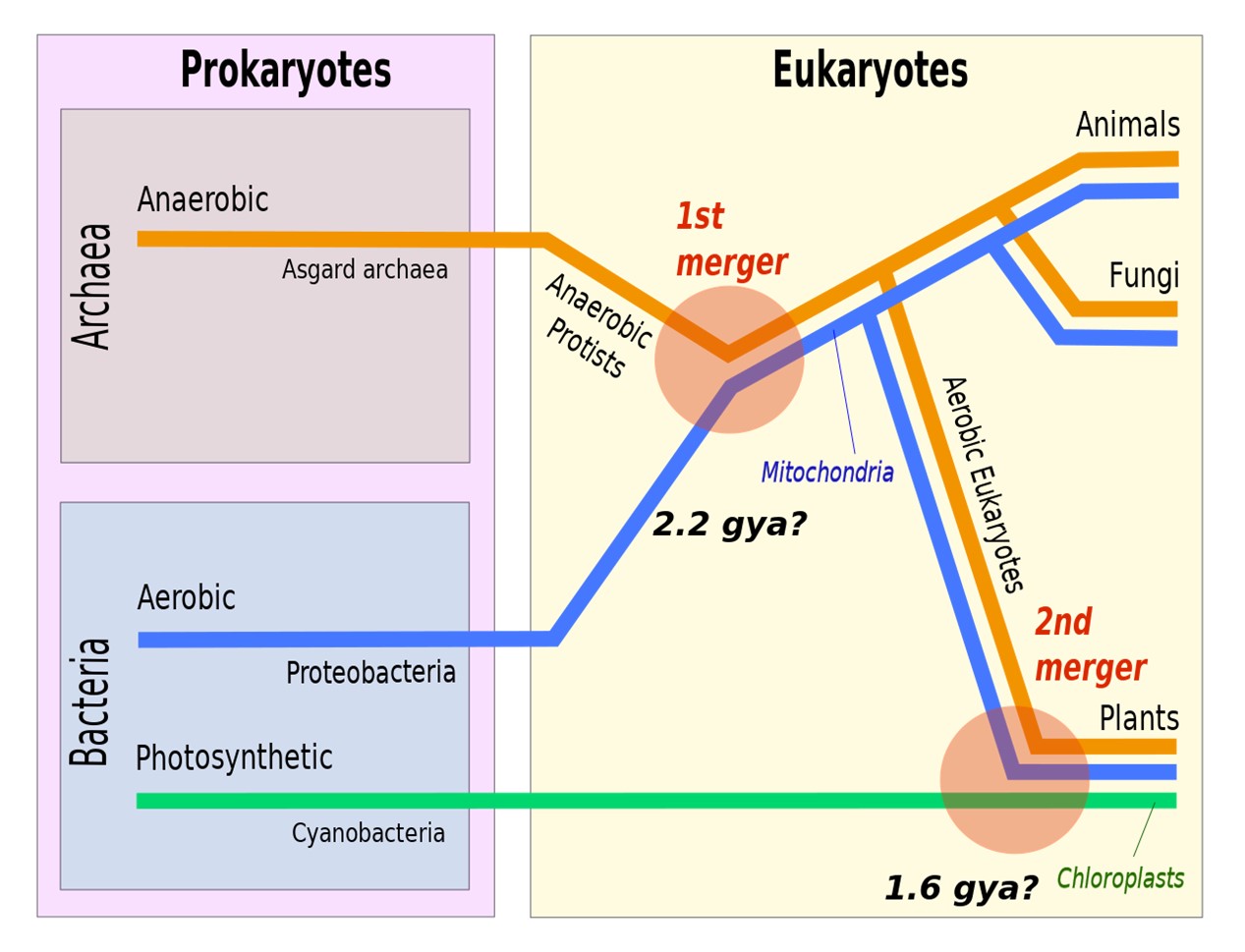
Endosymbiosis with two mergers, the first creating aerobic eukaryotes and the second producing photosynthetic organisms.
Credit: Chiswick Chap, CC BY-SA 4.0, via Wikimedia Commons
- Hundreds of millions of years later (2.2 Ba–600 Ma), the next huge step for multicellular life happened in a similar way for some mitochondria-bearing descendants. This repeat for a subset of the host descendants is known as serial endosymbiosis.
- A nucleated cell with mitochondria engulfed a photosynthetic cyanobacteria that provided solar power for that cell. Other aerobic eukaryote cells did the same.
- The cyanobacteria symbionts were assimilated then became organelles called chloroplasts, giving rise to the solar energy factories in plants and certain algae that form the base of Earth’s life-sustaining food chains and carbon cycle.
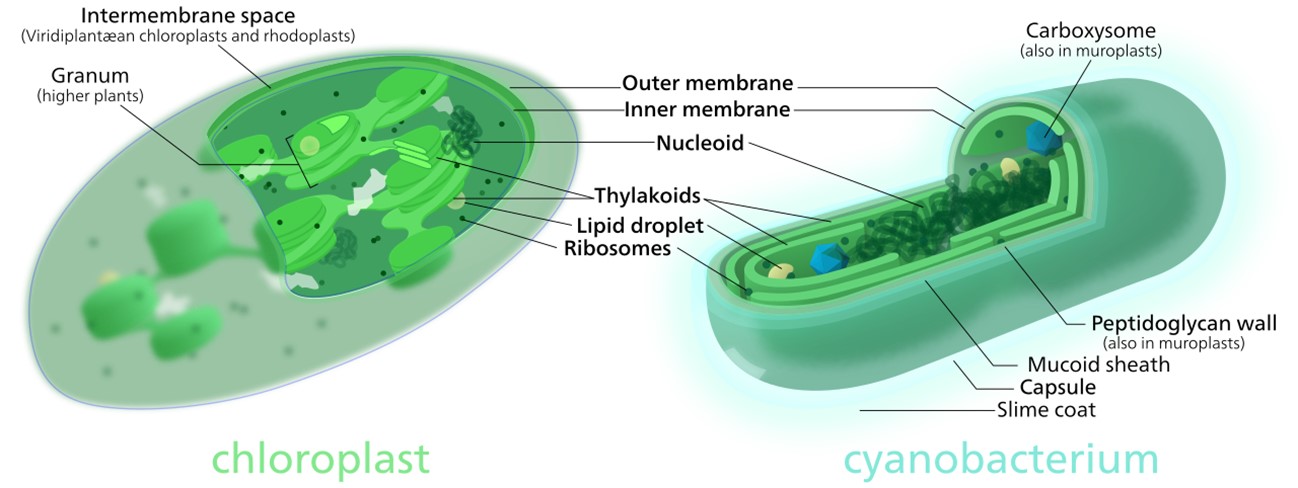
Photosynthesis fuels Earth’s biosphere as chloroplasts capture sunlight and transform carbon dioxide into carbohydrates, releasing oxygen. Chloroplasts are thought to have originated from cyanobacteria that were ingested by aerobic eukaryotes more than a billion years ago. This comparison of chloroplasts and cyanobacteria shows their similarities. Both chloroplasts and cyanobacteria have a double membrane, DNA, ribosomes and chlorophyll-containing thylakoids.
Credit: Kelvinsong, CC BY-SA 3.0, via Wikimedia Commons
- Now, scientists have caught a marine alga in an apparent third act of serial primary endosymbiosis, this time between a marine alga and a nitrogen-fixing microbe.
- Nitrogen is required for life and growth because it forms the structure of both the proteins and the DNA that provides the code for creating those proteins.
- Animals and fungi get their nitrogen by consuming plant matter.
- Nitrogen gas (N2) makes up 78% of the atmosphere, but to make it biologically available, its triple bond has to be broken.
- In nature, that superpower only belongs to a certain group of prokaryotes called nitrogen-fixing bacteria that “fix” it into ammonia (NH3).
- Humans can also synthesize ammonia for things like fertilizer using the Haber–Bosch process, which requires high temperatures and pressures, but about 1.4% of global carbon dioxide emissions come from this process.
- Many eukaryotes develop symbiotic relationships with nitrogen-fixing bacteria.
- Some plant species, like legumes, provide special docks on their roots for the bacteria, feeding them with carbon to receive a steady supply of nitrogen.
- Some smaller organisms, like algae, have incorporated endosymbiotic bacteria within their cells, but these are still independent operators.
- Recently, scientists discovered that a species of marine alga called Braarudosphaera bigelowii appears to have integrated a bacterium (Candidatus Atelocyanobacterium thalassa or UCYN-A) into its cell architecture as a new organelle—the nitroplast.
- This means the alga can fix nitrogen directly from the air for internal chemical reactions.
- The designation of the nitroplast as an organelle is based on the synchronization of replication and cell division between the alga and the bacterium.
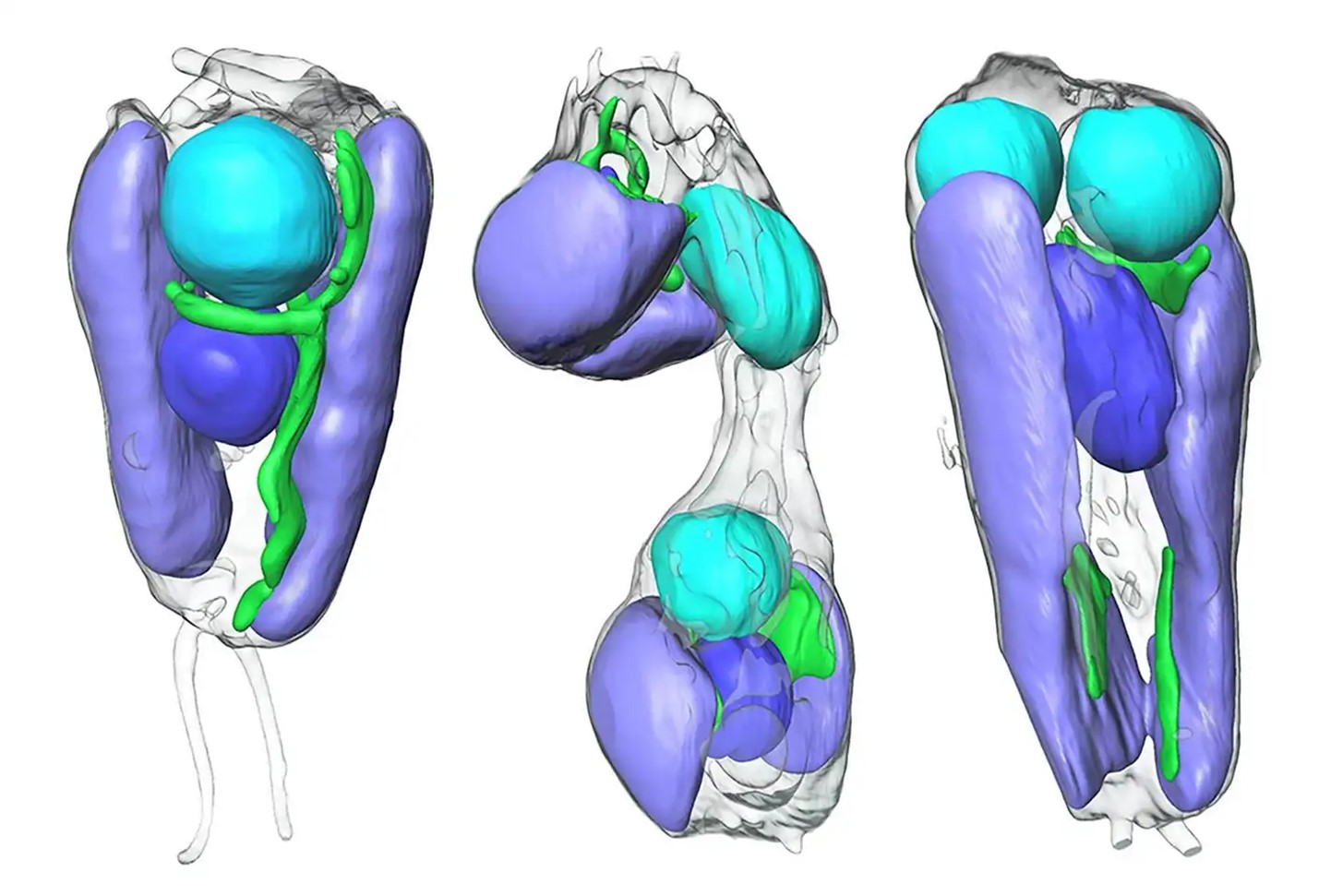
These images, generated by soft X-ray tomography performed by Berkeley Lab scientists, show the alga at different stages of cell division.
UCYN-A, the nitrogen-fixing entity now considered an organelle, is cyan. The algal nucleus is depicted in blue, mitochondria are green and chloroplasts are lilac.
Credit: Valentina Loconte/Berkeley Lab (DOE) - Additionally, the bacterium is now dependent on the alga for proteins and can no longer survive without its host.
- This is just the third time in Earth’s history that primary endosymbiosis has led to organellogenesis, and it probably began about 100 million years ago.
- Scientists are now looking for other plants that might be in the process of incorporating nitroplasts into their cells and at how the future of agriculture might benefit from natural nitrogen fixation.
- The mitochondrion enabled multicellular life and the chloroplast is the reason we have plants. What could the nitroplast bring?

